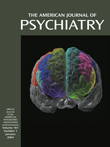Epidemiological studies indicate that generalized social anxiety disorder is among the most common of all psychiatric disorders, with lifetime prevalence estimates ranging from 7% to 12%
(1). Social anxiety disorder is associated with considerable functional impairment and reduced quality of life
(2,
3). Moreover, it has become increasingly apparent that disabling social anxiety accompanies other serious psychiatric disorders such as schizophrenia and depression, as highlighted in the papers by Pallanti et al. and Bruder et al. in this issue of the
Journal.
The report by Pallanti et al. is particularly instructive in this regard. They found that 36.3% of outpatients with schizophrenia met criteria for social anxiety disorder and that these patients had significantly higher lifetime rates of suicide attempts, greater lethality of attempts, more substance abuse, and lower overall quality of life. Social anxiety disorder is also frequently comorbid with major depression and atypical depression, which results in increased disability and reduced quality of life
(3,
4). In fact, as emphasized by the findings of Kessler et al.
(5), when the lifetime prevalence of major depression is considered, depression is frequently comorbid with anxiety disorders and is only rarely primary.
These data emphasize the importance of understanding the etiology and pathogenesis of social anxiety, not only in the context of social anxiety disorder as a discrete entity as defined by DSM-IV but also when comorbid with other neuropsychiatric disorders.
The phenotypic expression of social anxiety depends on both genetic and environmental factors. Investigations by Schwartz et al.
(6) have shown that behavioral inhibition to novelty very early in life increases the risk for the development of social anxiety disorder later in life, suggesting the importance of genetic factors. Stein and associates
(7) have found that a cognitive dimension (as measured by the Fear of Negative Evaluation Scale) related to the experience of social anxiety was moderately heritable. Preclinical studies have also suggested that specific genes may contribute to social behaviors
(8). Twin and family studies have suggested that both genetic and environmental factors contribute to social anxiety
(9). For example, parental psychopathology (particularly social anxiety and depression) and parental style (overprotection and rejection) may interact with a genetic predisposition to increase the risk of social anxiety disorder
(10).
Insufficient attention has been paid toward elucidating the neurobiological basis of social anxiety. Few neuroimaging studies of social anxiety disorder patients have been conducted. One noteworthy investigation reported preliminary evidence of amygdala hyperactivity in response to angry and contemptuous faces
(11). The neurochemical modulation of social anxiety has also scarcely been studied; a role for dopamine and serotonin neural systems has been suggested
(12).
In this context, the paper by Bruder and colleagues in this issue of the
Journal is welcome. The primary finding of their study was that patients with social anxiety disorder with or without comorbid depression had a decreased left hemispheric advantage for processing words or syllables. As noted by the authors, the reduced left hemisphere processing is not specific to patients with social anxiety in that it is also observed in patients with obsessive-compulsive disorder
(13) and schizophrenia
(14,
15). Their speculation that the deficit in the left hemisphere processing of verbal stimuli may have clinical relevance to the anxiety experienced in social situations and may be related to the mechanisms of action of cognitive behavior therapy deserves further study.
Disabling social anxiety is a major public health problem
(16). It is not restricted to social anxiety disorder but is an important symptomatic feature of numerous psychiatric disorders. The observations that the experience of social anxiety span DSM-IV-based conditions provide another example of the limitations of a diagnostic system not based upon etiology
(17). Spectacular advances in the cognitive neuroscience of social behavior
(18) provide a framework from which to investigate the neural basis of social anxiety
(19). In the near future, it will be important to determine if the etiology of social anxiety varies depending upon the co-occurring psychiatric disorders. These investigations promise to contribute to identification of new molecular targets relevant to drug treatment discovery and novel psychotherapeutic approaches for social anxiety.

